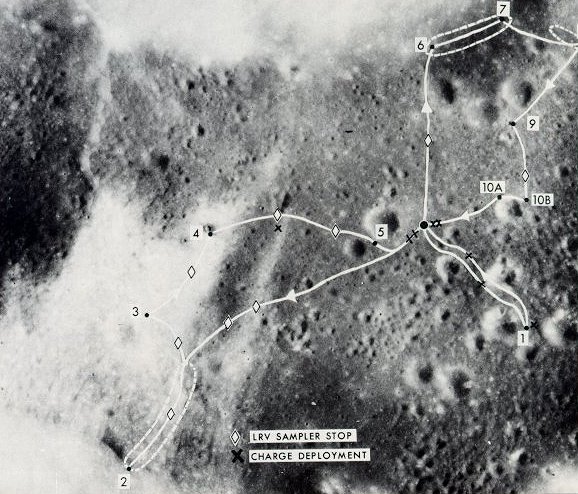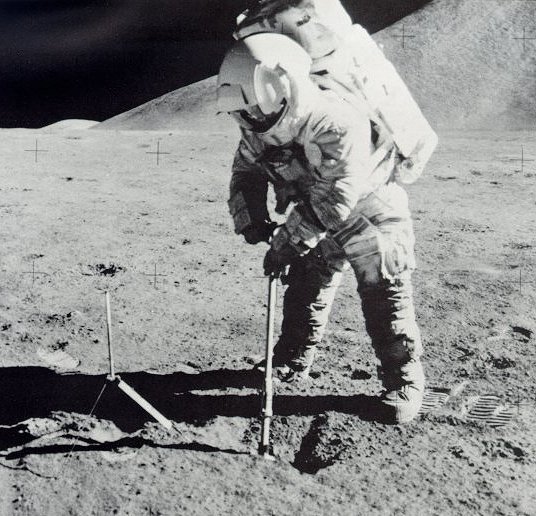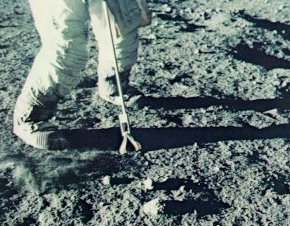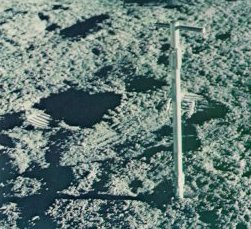Apollo Expeditions to the Moon
THE MISSIONS OF UNDERSTANDING
The last three Apollo journeys were great missions of
understanding during which our interpretation of the evolution of
the Moon evolved. In July 1971 the first of these missions,
Apollo 15, visited Hadley Rille at the foot of the Apennine
Mountains. Apollo 15 gave lunar exploration a new scale in
duration and complexity. Col. David R. Scott, Col. James B.
Irwin, and Lt. Col. Alfred M. Worden looked at the whole planet
for 13 days through the eyes of precision cameras and electronics
as well as the eyes of men. Scott and Irwin spent nearly 67 hours
on the Moon's surface, and were the first to use a wheeled
surface vehicle, the Rover, to inspect a wide variety of
geological features. Finally, before returning to Earth, they
placed a small satellite in lunar orbit that greatly expanded our
knowledge of the distribution and geological correlation of
gravitational and magnetic variations within the Moon's crust.
| | |
Sampling scoop in hand, I go questing at Station 5 by Camelot
Crater. At this point I had already collected a load of samples,
and will shortly curve back to the Rover, off-camera at left, to
unload. This was our second EVA, covering some 11 miles.
|
The varied samples and observations from the vicinity of
Hadley Rille and the mountain ring of Imbrium called the Apennine's
pushed knowledge of lunar processes back past the four-billion-
year barrier we had seemed to see on previous missions. We also
discovered that lunar history behind this barrier was partially
masked by multiple cycles of impact melting and fragmentation.
Nevertheless, the rock fragments we sampled gave vague glimpses
into the first half-billion years of lunar evolution and into
some details of the nature of the melted shell. Part of this view
into the past was provided by the well-known "Genesis Rock" of
anorthosite (a plagioclase-rich rock). In addition, we expanded
our understanding of the complex volcanic processes that created
the present surfaces of the maria. These processes were now seen
to have included not only the internal separation of minerals
within lava flows but possible processes of volcanic erosion and
fracturing that could have created the rilles.
| | |
Our three traverses on Apollo 17 came very close to
those we had preplanned, differing only because of
unexpected findings. The fist run was a mile and a quarter to
Steno Crater and back, in the 4 o'clock position above. The second
was the longest, at 5 o'clock. At station 4 near Shorty Crater
we found the orange soil (see here).
The third run, at 12 to 1 o'clock, was more than six miles. The
great fractured boulder shown here
is on the slope near Station 6.
|
The Apollo 15 astronauts placed instruments on the Moon
which, in conjunction with earlier missions, finally established
a geophysical net of stations. Of particular importance was a net
of seismometers by which we began to decipher the inner structure
of the Moon. Correlations of information from these stations with
other facts enabled us to interpret several major portions of the
interior. The Moon's crustal rocks, rich in the calcium and
aluminum silicate plagioclase, are broken extensively near the
surface but more coherent at depths from 15 to 40 miles. The
crust rests on an upper mantle 125 to 200 miles thick that
contains the magnesium and iron silicates, pyroxene and olivine.
From about 200 or 250 to about 400 miles deep, the lower mantle
is possibly similar to some types of stony meteorites called
chondrites. From about 400 miles to about 700 miles deep, the
chondrite material appears to be locally melted and seismically
active. There are also many reasons now to believe that the Moon
has an iron-rich core from about 700 miles deep to its center at
1080 miles that produced a global magnetic field until only
recent times.
| | |
Sampling by scoop was the main way we obtained the large numbers
of small samples that provide good statistical information about
the composition of the surface. That instrument to the left of
Apollo 15's Jim Irwin is a gnomon. It provides a vertical-seeking
rod of known length, a color chart, and a shadow - all useful
for calibrating pictures.
|
| | |
Sampling tongs and coring tubes gave us other means of
collecting special samples. The spring-loaded tongs below let us
pick up small rocks and fragments without getting down on our
knees or otherwise reaching way down with clumsy gloves. The
core tubes were hammered down into the soil and then drawn back
out and capped. They gave us a way to collect sections of soil that
preserved the relative relationships undisturbed.
|
The geophysical station at Hadley-Apennines also told us
that the flow of heat from the Moon was possibly two times that
expected for a body having approximately the same radioisotopic
composition as the Earth's mantle. If true, this tended to
confirm earlier suggestions that much of the radioisotopic
material in the Moon was concentrated in its crust. Otherwise,
the interior of the Moon would be more fluid and show greater
activity than we sense with the seismometers.
| | |
Finding orange soil near Station 4 on Apollo 17 at the
time when oxygen was running low kept us on the jump. We dug a trench
8 inches deep and 35 inches long, took samples of the orange soil and
nearby gray soil, drove a core tube into the deposit, sampled
surrounding rocks, described and photographed the crater site in
detail, and packed the samples - all in 35 minutes. The effort gave
scientists a most unusual sample: very small beads of orange volcanic
glass, formed in a great eruption of fire fountains over
3.5 billion years ago.
|
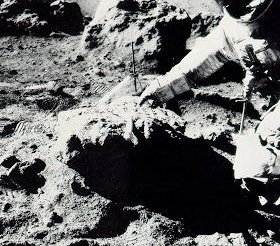
|
Rocks too big to bring back were studied where
they were, described and photographed, and
sampled by chipping pieces from their corners.
If we could roll the rock over, as above,
we could take soil samples underneath that had been
shielded from the effects of solar and cosmic radiation.
|
We began with Apollo 15 to be able to correlate our landing
areas around the whole Moon by virtue of very-high-quality
photographs and geochemical x-ray and gamma-ray mapping from
orbit. The x-ray remote sensing investigations disclosed the
provincial nature of lunar chemistry, particularly by
highlighting differences in aluminum-to-silicon and magnesium-to-
silicon ratios within the maria and the highlands. By outlining
variations in the distribution of uranium, thorium, and
potassium, the gamma-ray information suggested that large basin-
forming events were capable of creating geochemical provinces by
the ejection of material from depths of six or more miles.
Possibly of equal importance with all these findings by
Apollo 15 was the discovery - shared through television by
millions of people - that there existed beauty and majesty in
views of nature that had previously been outside human
experience.
The mission of Apollo 16 to Descartes in April 1972 revealed
that we were not yet ready to understand the earliest chapters of
lunar history exposed in the southern highlands. In the samples
that Capt. John W. Young, Comdr. Thomas K. Mattingly. and Col.
Charles M. Duke, Jr., obtained in the Descartes area, the major
central events of that history seemed to be compressed in time
far more than we had guessed. There are indications that the
formation of the youngest major lunar basins, the eruption of
light-colored plains materials, and the earliest extrusions of
mare basalts required only about 100 million years of time around
3.9 billion years ago.

|
The basaltic lavas of the lunar maria, like this
sample photographed after return to a laboratory
on Earth, tell much about the partial melting of the
Moon between three and four billion years ago.
This sample, 70017, is identified in its
documentation photograph by the number of the
counter and by the B orientation code.
|
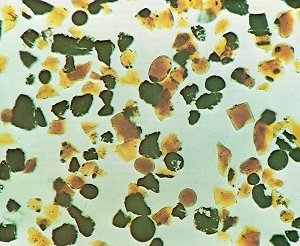
|
Ancient beads of orange volcanic glass in
the photomicrograph above have revealed secrets
of the Moon's deep interior. Produced most likely
by the partial melting of the lunar mantle,
and discovered by Apollo 17, these beads are
unusualy rich in such volatile elements as lead,
zinc, tellurium, and sulfur. This indicates not
only volcanic origin but also derivation from
rocks possibly as deep as 200 miles in the
Moon. Similar glass beads, green in color,
were discovered by Apollo 15.
|
The extreme complexity of the problem of interpreting the
lunar highland rocks and processes became evident even as the
Apollo 16 mission progressed. Rather than discovering materials
of clearly volcanic origin as many expected, the men found
samples that suggested an interlocking, sequence of igneous and
impact processes. A new chemical rock group known as "very high
aluminum basalts" could be defined, although its ancestry
relative to other lunar materials was obscured by later events
that gave the cratered highlands their present form. The results
of Apollo 16 have within them an integrated look at almost all
previously and subsequently identified highland rock types. With
this complexity comes a unique, as yet unexploited, opportunity
to understand the formation and modification of the Moon's early
crust and potentially that of the Earth.
The materials found in the Descartes region were similar to
those sampled slightly earlier by Luna 20 in the Apollonius
region. But there were significant differences in the aluminum
content of debris representative of the two regions. Also there
were differences in the abundance of fragments of distinctive
crystalline rocks known as the anorthosite-norite-troctolite
suite. After Apollo 15, this suite of rocks had been recognized
as possibly being a much reworked leftover of at least portions
of the ancient lunar crust. Luna 20 and Apollo 16 confirmed its
great importance to the understanding of the ancient melted
shell.
|


